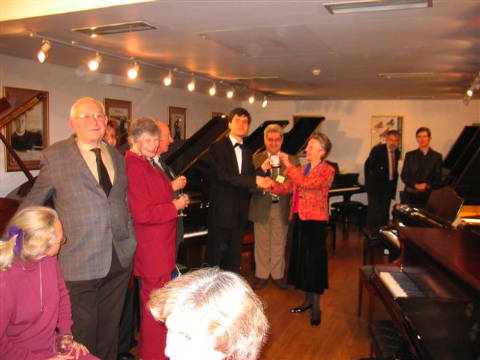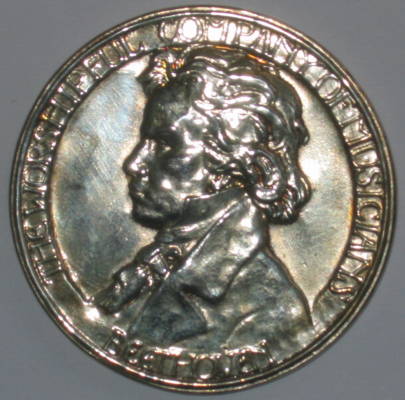|
POTENTIAL AND ACHIEVEMENT

The sixteenth Beethoven
Intercollegiate Piano Competition,
experienced by JULIAN JACOBSON
Driving into Mayfair to attend the Beethoven Piano Society of Europe's 16th Annual Beethoven Intercollegiate Competition [Sunday 30 November 2008], I happened to be listening to some marvellous solo outtakes of Thelonious Monk in 1957, exploring his own classic tune Round Midnight. Did any 20th-century pianist exhibit more sheer creativity, or convey more strongly the impression of actually thinking aloud?
Beethoven, too, needs that sense of questing, of creating the music from moment to moment. He also needs a powerful grasp of thematic and harmonic structure, a rich but not over-cultivated piano sonority, a burning emotional intensity, and -- last but not least -- most of the right notes. Artur Schnabel got it just about right; and Monk replicated many Beethovenian attributes in his own toughly anti-sentimental, linear bebop language. Which of the gifted young pianists, already winners of their own college's Beethoven Competition, could indicate that they were on the right road and give us an authentic, three-dimensional Beethoven experience? A sonata to remember?
Nikos Stavlos (Goldsmiths College Music Department) is certainly on the right road. His C major Sonata Op 2 No 3 sounded like the real thing, although he misjudged the acoustic initially with playing that was a little dry, and his finale slightly let him down. But there's a keen musical intelligence developing.
From the Royal Welsh College of Music and Drama, Matthew Drinkwater showed energy and some responsiveness in 'Les Adieux' but his message was compromised by technical insecurity. Tatiana Dardykina (Birmingham Conservatoire) had a rather dreamy way with the compulsory Bagatelle (the witty, somewhat gnomic Op 126 No 6 in E flat), carried over into the Arietta finale of her C minor Sonata Op 111, the first of the day's three performances of this work. But her first movement showed more resolution, with good control and some characterful playing.
Gintaute Gataveckaite, from the Royal Northern College of Music, was also inclined to rhapsodise in the Bagatelle. But her E flat Fantasy-Sonata, Op 27 No 1, settled into some pretty good playing, concentrated and natural, stylistically and structurally convincing, only lacking an ounce or two of temperament.
Konstantin Lapshin (Royal College of Music) came over as a fine player not quite at home in his chosen 'Moonlight' Sonata (the other of the two Op 27 Fantasy-Sonatas). His Allegretto second movement was unenticing (when will pianists realise this is one of the hardest movements in all the sonatas?), and his finale was hard-driven and somewhat gabbled. Yet his Bagatelle, played for once after the sonata, was one of the day's best performances.
Matthew McCombie (Trinity Laban) disappointed with a ploddy Bagatelle, but there was more to enjoy in an energised Op 111 first movement. The pacing and punctuation weren't quite right though: again, I thought, listen to Monk and Schnabel! (To be sure, Thelonious never recorded Op 111 but he did have the most wonderful way with pauses.) McCombie's Arietta was overladen with 'points', becoming somewhat sentimentalised.
From the Guildhall School of Music and Drama, Veneta Neynska missed the character of the Bagatelle, though her playing certainly had intensity. Her E flat Sonata Op 31 No 3, one of Beethoven's great comedies-of-manners, was considerably more enjoyable, lively and energetic, with the middle movements particularly well characterised (although the Trio section of the third movement was over-characterised -- surely Beethoven shouldn't sound 'cute').
Ayako Kanazawa, from the Royal Scottish Academy of Music and Drama, showed an engaging personality in the Bagatelle, warm and impulsive (maybe veering towards frisky). The A flat Sonata Op 110 suited her warm, caring playing, even if it came across as slightly romanticised, with a tendency to split hands and with over-generous if never unmusical pedalling. She conveyed the sheer oddness of the second movement well, and displayed good part-playing in the fugue.

Presentation of the Beethoven Medal to first prize winner Andrejs Osokins by Petronella Dittmer, the new Lady Master of the Worshipful Company of Musicians. From left to right: Heleen Mendl-Schrama (correspondent for the Dutch Pianowereld), Barry Saipe and Norma Fisher, Audrey Ellison (J Audrey Ellison International Artists' Management), William Brown CBE (Patron), Nadia Lasserson (foreground), first prize winner Andrejs Osokins, Marios Papadopoulos (chairman of the jury) and Petronella Ditmer. Photo © 2008 Harry Atterbury
|
As Andrejs Osokins (Royal Academy of Music) began his Bagatelle I noted down simply: 'Well, this is the real thing'. Nothing he did subsequently gave me reason to revise this all-important first impression. In the Bagatelle, he somehow made sense of the pedalling in a way that none of the others had quite managed, and his playing had an extraordinary concentration and distilled poetry. In the day's last Op 111 he convinced me that he had, as it were, the right to play this Everest of sonatas, with a maturity of phrasing and a grasp of the longer structure (including those vital pauses!) that were deeply satisfying. Occasionally in the first movement he could have risked rougher, more elemental playing, and his coda, that magical wind-down, was rather literal -- but this will surely come. He also had the measure of the Arietta, with a tempo that flowed just enough to convey the august momentum of Beethoven's varied yet implacable three-in-a-bar. The extraordinary variation where Beethoven seems to invent boogie-woogie was a little too forceful for its 'cosmic dance' to take fire; but more or less everything in Osokins' performance was meaningful and well-heard, and he was the deserving winner of the first prize.

The Worshipful Company of Musicians' Beethoven medal. Photo © 2008 Harry Atterbury
|
Second prize went to Gintaute Gataveckaite and third prize to Veneta Neynska, with an honourable mention for Nikos Stavlos. The Jury also expressed their appreciation of Ayako Kanazawa and Tatiana Dardykina.

From left to right: Petronella Dittmer, Andrejs Osokins, Heleen Mendl-Schrama, Norma Fisher and Marios Papadoulos. Photo © 2008 Harry Atterbury
|
The Competition was held as in previous years at the Blüthner Piano Centre in London, generously hosted by Mr Roger Willson. The Lady Master of the Worshipful Company of Musicians (the first such in the Company's 500-year history), Petronella Dittmer -- herself a professional musician -- presented the Company's Beethoven Medal to Andrejs Osokins, with some inspiring words for all the contestants.

Andrejs Osokins with BPSE committee member Norma Fisher. Photo © 2008 Harry Atterbury
|
Osokins also received the Eugenie Maxwell Award of 500 pounds, although Mrs Maxwell, in her role of Vice-President of the Beethoven Society, was unable to be present. William Brown CBE and Mrs Nachiko Brown, Patrons of the Society, were on hand to present their prizes and say a few words of congratulation. The distinguished jury comprised Dr Marios Papadopoulos, Mr Stephen Savage and Professor Malcolm Troup; Dr Papadopoulos, as Chairman of the Jury, announced the results and drew favourable attention to the admirably high standard of the playing throughout.

Andrejs Osokins is congratulated by jury member Malcolm Troup and master of ceremonies Alberto Portugheis. Photo © 2008 Harry Atterbury
|
Copyright © 16 December 2008 Julian Jacobson, London UK

|

